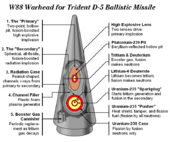W88 (nuclear weapon)
The W88 is a thermonuclear warhead of the United States .
history
The W88 is the youngest warhead in the US arsenal. It was developed by Los Alamos National Laboratory (LANL) and Sandia for the Trident II D-5 - SLBM to be stationed on the Ohio-class SSBN . The aim was to develop a warhead with a relatively high explosive power and high accuracy for fighting "hard" targets such as missile silos. The W76 warhead, also developed for the Trident, was unable to do this. The basic design dates from the 1970s and could be tested with full explosive power before the Threshold Test Ban Treaty came into force in 1976. Concrete development work on the warhead began in March 1984 at Los Alamos National Laboratory (LANL). Development work on the final production design began in March 1986 and the first warheads were completed in March 1989. Mass production began in April 1989 with 4,000 to 5,000 units planned. However, the plant for the production of the plutonium cores in Rocky Flats was finally closed in November 1989 after a raid by the FBI because of environmental and safety problems. This also ended the production of the W88. Admiral Raymond G. Jones Jr. stated that enough W88 warheads had been produced to equip 4 Ohio-class submarines, which at 8 warheads and 24 missiles per boat is about 800 units. However, most sources give a number of 400 warheads. According to the Bulletin of Atomic Scientists' Nuclear Notebook, 384 W88s were in active service at the end of 2008, with another 20 in reserve.
By closing the Rocky Flats facility, the United States was unable to manufacture plutonium cores for nuclear weapons until mid-2003. That year, the TA-55 facility in Los Alamos produced the first new certifiable plutonium core for a W88 warhead since 1989. This plant is supposed to produce up to 10 cores per year for the W88, which are supposed to replace cores destroyed for test purposes.
In 1995, the CIA leaked secret Chinese documents containing detailed information about the W88, Trident II D-5 and other US thermonuclear warheads. In the course of the investigation of this espionage case , more general information about the structure of the W88 became public.
design

The W88 is a non-spherical, two-stage variant of the Teller-Ulam design with an explosive force of 475 kt . Its structure largely corresponds to that of the W87 warhead designed by the Lawrence Livermore National Laboratory . The first stage of the weapon consists of a plutonium sphere filled with deuterium - tritium gas with a neutron reflector made of beryllium . The chemical explosive that implosions the core is PBX-9501, a special polymer-bound explosive that is detonated at two points. The fusion explosive is lithium deuteride with 95% 6 Li. The fusion stage is surrounded with highly enriched uranium . The W88 is housed in an Mk5 re-entry head. This has an aluminum structure coated with a graphite - epoxy composite material and a carbon fiber composite material as a heat shield. The Mk5 is largely identical to the Mk21 re-entry head of the W87. The warhead electronics are hardened against nuclear effects.
Data
| Explosive device | W88 |
|---|---|
| Re-entry head | Mk5 |
| status | active stock |
| operator | US Navy |
| developer | LANL , SNL |
| Start of development | 1984 |
| Start of production | April 1989 |
| End of production | December 1989 |
| number of items produced | > 400 |
| design | Teller-ulam , two-tiered, not spherical |
| Dimensions W88 / Mk5 | under 360 kg |
| Length W88 / Mk5 | 1.75 m |
| maximum diameter W88 / Mk5 | 0.55 m |
| Explosive power | 475 kt |
| Carrier system | Trident II D-5 |
| Number per carrier | 4–6 (max. 8 through START-1) |
| Scattering circle radius | about 100 m |
